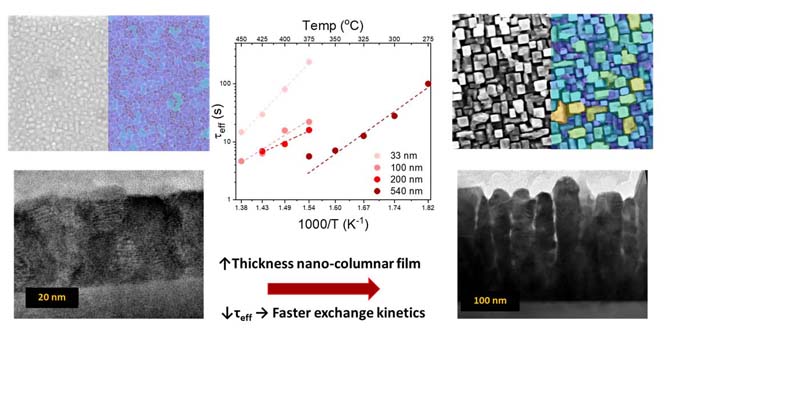Lanthanum nickelate (L2NO4, La
2NiO
4+δ) is a mixed ionic electronic conducting (MIEC) oxide, which shows a great potential for its use in nanoionic devices in the form of thin films. In the Nanoionics group at LMGP we study this Ruddlesden-Popper phase for several different applications, such as memristive devices and oxygen electrodes in solid oxide fuel cells (SOFCs) and electrolysers.
Interface-type oxide-based valence change memories (VCMs) with analog switching capabilities and memory transience are interesting candidates to be used as artificial synapses for the hardware implementation of artificial neural networks. Our first studies devoted to L2NO4 memristive devices grown on single crystal substrates, either directly on SrTiO
31,2, or as a L2NO4/LaNiO
3 bilayers
3 showed very promising results, with bipolar analog-type switching characteristics and gradual transitions between the high and low resistance states (HRS and LRS). Recently, these novel L2NO4-based devices were successfully transferred to the vertical configuration on silicon-based substrates, retaining the analog-type switching characteristics and allowing for the future development of these promising devices in applications such as artificial synapses for neuromorphic computing with bio-inspired learning.
4
Furthermore, by tuning the Metal Organic Chemical Vapor Deposition (MOCVD) conditions, L2NO4 can also be grown either dense or in the form of nano-columnar thin films, with a very high surface area, allowing for much faster oxygen exchange kinetics, greatly lowering the polarization resistance of the oxygen electrode in SOFCs.
5
REFERENCES
1. K. Maas, E. Villepreux, D. Cooper, C. Jiménez, H. Roussel, L. Rapenne, X. Mescot, Q. Rafhay, M. Boudard and M. Burriel*, Using a mixed ionic electronic conductor to build an analog memristive device with neuromorphic programming capabilities,
J. Mater. Chem. C, 8, 464 (2020). Back Cover
2. K. Maas, C. Wulles, J. M. Caicedo, B. Ballesteros, V. Lafarge, J. Santiso*, and M. Burriel*, Role of pO2 and film microstructure on the memristive properties of La2NiO4+δ/LaNiO3-δ bilayers,
J. Mater. Chem. A, 10(12), 6523 (2022). Inside Front Cover
3. K. Maas, E. Villepreux, D. Cooper, E. Salas-Colera, J. Rubio-Zuazo, German R. Castro, O. Renault, C. Jiménez, H. Roussel, X. Mescot, Q. Rafhay, M. Boudard and M. Burriel*, Tuning Memristivity by Varying the Oxygen Content in a Mixed Ionic–Electronic Conductor,
Adv. Funct. Mater. 30 (17), 1909942 (2020). Article highlighted in the ESRF Highlights 2020 annual booklet
4. T.-K. Khuu, G. Lefèvre, C. Jiménez, H. Roussel, A. Riaz, S. Blonkowski, E. Jalaguier, A. Bsiesy, and M. Burriel*, La2NiO4+δ-Based Memristive Devices Integrated on Si-Based Substrates,
Adv. Mater. Technol., 7 (11) 2200329 (2022). Article highlighted in the "Women in Materials Science" virtual issue.
5. A. Stangl*, A. Riaz, L. Rapenne, J. M. Caicedo, J. de Dios Sirvent, F. Baiutti, C. Jiménez, A. Tarancón, M. Mermoux, M. Burriel*, Tailored nano-columnar La2NiO4 cathodes for improved electrode performance, J
. Mater. Chem. A, 10, 2528 (2022)
Cette activité est portée par
Monica Burriel
